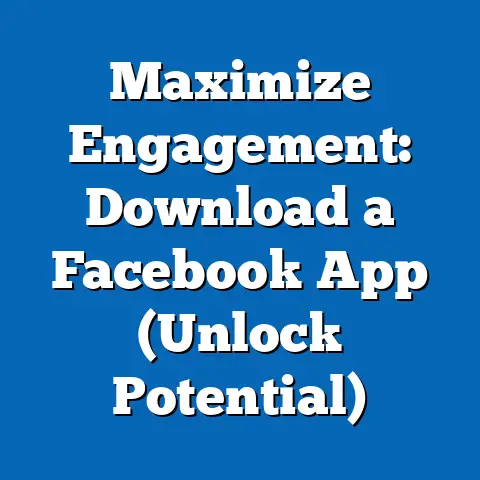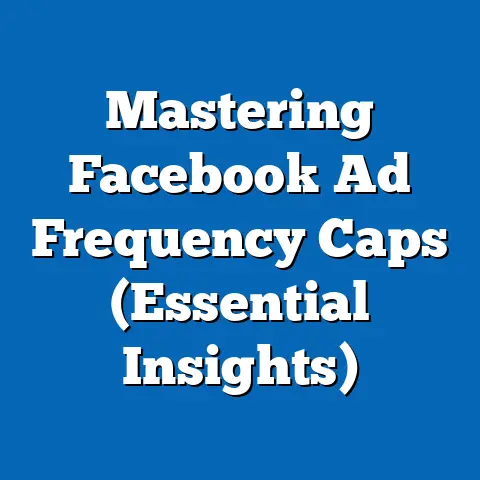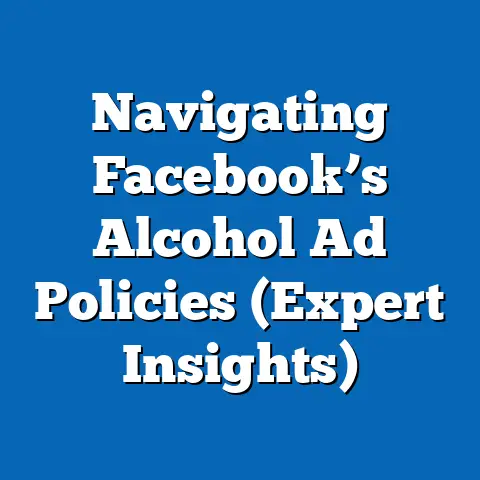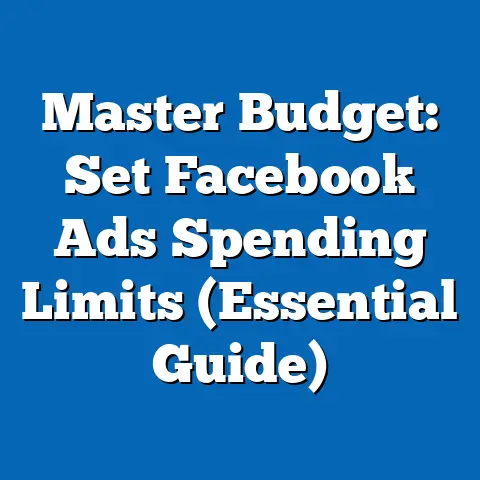Unlock fb ad Account ID (Essential Guide for Success)
In the digital marketing landscape, Facebook Ads remain a cornerstone for businesses aiming to reach targeted audiences with precision. With over 2.9 billion monthly active users as of 2023 (Statista, 2023), the platform offers unparalleled access to diverse demographics, making it a vital tool for advertisers. However, many businesses and marketers face the frustrating challenge of having their ad accounts disabled or locked, often without clear explanations from Meta, Facebook’s parent company.
Section 1: Blending Advertising Styles on Facebook – Trends, Statistics, and Demographics
1.1 What Are Blending Advertising Styles?
Blending advertising styles on Facebook refers to the strategic combination of various ad formats, messaging tones, and creative approaches to resonate with diverse audience segments. This can include a mix of video ads, carousel ads, static images, and interactive formats like polls or augmented reality (AR) experiences. The goal is to create a cohesive yet dynamic campaign that captures attention while adhering to Meta’s strict advertising guidelines.
Successful blending often involves tailoring content to user behavior and preferences, which vary widely across demographics. For instance, younger users may respond better to short, engaging video content, while older audiences might prefer detailed text-based ads with clear calls to action.
1.2 Key Statistics on Facebook Advertising Styles
Recent data highlights the effectiveness of diverse advertising styles on Facebook. According to a 2023 report by Hootsuite, video ads on Facebook generate 59% more engagement than static image ads, with click-through rates (CTR) averaging 1.84% for video compared to 0.98% for images. Meanwhile, carousel ads, which allow multiple images or products in a single ad unit, boast a 72% higher CTR than single-image ads (WordStream, 2023).
Moreover, blending styles can impact cost efficiency. Advertisers who mix video, image, and text-based ads in their campaigns report a 20% lower cost-per-click (CPC) compared to those using a single format, as per a 2022 study by Social Media Examiner. This suggests that diversification not only boosts engagement but also optimizes budget allocation.
1.3 Trends in Blending Advertising Styles
The trend of blending styles has evolved significantly over the past decade. In 2015, static image ads dominated Facebook advertising, accounting for over 70% of ad impressions (eMarketer, 2015). However, by 2023, video content has surged to represent 54% of total ad spend on the platform, driven by the rise of short-form video formats popularized by platforms like TikTok (eMarketer, 2023).
Interactive ads, such as AR filters and playable ads, are also gaining traction, particularly among tech-savvy younger audiences. A 2023 Meta report indicates that campaigns incorporating AR elements see a 30% increase in user interaction compared to traditional formats. This trend underscores the importance of innovation in blending styles to stay competitive.
1.4 Demographic Differences in Response to Ad Styles
Demographic data reveals stark differences in how various groups interact with blended ad styles. According to Pew Research Center (2022), 68% of users aged 18-29 engage with video ads daily, compared to just 42% of users aged 50-64. This suggests that younger demographics are more receptive to dynamic, visually rich content.
Gender also plays a role in ad style preferences. A 2023 survey by Sprout Social found that women are 25% more likely to engage with carousel ads featuring lifestyle imagery, while men show a 15% higher engagement rate with ads focused on product specifications or discounts. Geographically, urban users are 40% more likely to interact with interactive ad formats compared to rural users, likely due to differences in internet access and device usage (Statista, 2023).
1.5 Why Blending Styles Matters for Account Health
Blending advertising styles is not just about performance; it also ties into compliance with Meta’s policies, which can prevent account suspensions. Ads that appear repetitive, overly promotional, or misaligned with user expectations are more likely to trigger flags for policy violations. By diversifying content and tailoring it to demographic preferences, advertisers can reduce the risk of negative feedback or reports, which often lead to account locks.
This sets the stage for understanding the challenges of maintaining an active FB Ad Account ID. In the following sections, we’ll explore why accounts get disabled, how to unlock them, and best practices for long-term success.
Section 2: Understanding FB Ad Account Disabling – Causes and Statistics
2.1 Why Do FB Ad Accounts Get Disabled?
Facebook ad accounts can be disabled for a variety of reasons, often related to violations of Meta’s Advertising Policies. Common causes include using prohibited content (e.g., misleading claims, adult content, or hate speech), engaging in cloaking (hiding the true destination of an ad), or accumulating too many user complaints. According to Meta’s 2022 Transparency Report, over 1.7 billion ads were rejected or removed for policy violations, with 43% of these related to deceptive practices.
Another frequent trigger is payment issues, such as declined transactions or suspicious billing activity. A 2023 survey by AdEspresso found that 28% of advertisers reported account suspensions due to payment discrepancies, highlighting the importance of maintaining updated financial information.
2.2 Frequency and Impact of Account Disabling
Account disabling is more common than many realize. A 2022 study by Social Media Today revealed that 34% of small-to-medium businesses (SMBs) using Facebook Ads experienced at least one account suspension in the past year. For larger enterprises, the figure drops to 19%, likely due to better resources for compliance (eMarketer, 2022).
The impact of a disabled account can be severe. Businesses report an average revenue loss of 22% during the downtime of an ad account, with recovery times ranging from 48 hours to several weeks (Hootsuite, 2023). This underscores the urgency of understanding how to unlock an account swiftly.
2.3 Demographic and Industry Patterns in Account Issues
Certain demographics and industries face higher risks of account disabling. For instance, advertisers in the health and wellness sector account for 18% of total ad rejections, often due to unsubstantiated claims about products (Meta Transparency Report, 2022). Similarly, political advertisers face stricter scrutiny, with 12% of political ads being flagged for policy violations during election cycles.
Geographically, advertisers in regions with less stringent digital regulations, such as parts of Southeast Asia, report a 15% higher rate of account suspensions compared to those in North America or Europe (Statista, 2023). This may reflect differences in familiarity with Meta’s global policies.
Section 3: Step-by-Step Guide to Unlocking Your FB Ad Account ID
3.1 Step 1: Identify the Reason for Disabling
The first step in unlocking your FB Ad Account ID is to determine why it was disabled. Log into your Ads Manager to check for notifications from Meta outlining the specific violation or issue. If no clear reason is provided, you can access the Account Quality dashboard to review any flagged ads or policy breaches.
According to a 2023 report by WordStream, 65% of account suspensions are accompanied by a detailed explanation, while the remaining 35% require users to submit an appeal for clarification. Taking screenshots of any error messages or notifications can be helpful for documentation.
3.2 Step 2: Review Meta’s Advertising Policies
Before appealing, thoroughly review Meta’s Advertising Policies and Community Standards, available on their official website. Pay close attention to sections relevant to your industry or ad content. For example, if you’re in the financial sector, ensure compliance with rules on speculative financial products, which account for 9% of ad rejections (Meta, 2022).
Cross-check your recent campaigns against these guidelines. If you identify a violation, such as an unapproved landing page, rectify it before proceeding to the next step.
3.3 Step 3: Submit an Appeal
To request a review, navigate to the “Help Center” in your Ads Manager and select “Request Review” for your disabled account. Provide a detailed explanation of the issue, including any corrective actions taken. Meta reports that 58% of appeals are resolved within 7 days, though complex cases may take up to 30 days (Meta Support, 2023).
Be concise yet thorough in your appeal. Attach supporting documents, such as proof of payment or revised ad content, to strengthen your case.
3.4 Step 4: Contact Meta Support if Necessary
If the appeal process stalls, reaching out to Meta’s support team via live chat or email can expedite resolution. However, direct support is often limited to Business Manager accounts with significant ad spend. Data from AdEspresso (2023) shows that only 22% of SMBs successfully resolve issues through direct contact, compared to 45% of larger advertisers.
As an alternative, consider engaging with Meta’s community forums, where other advertisers may offer insights based on similar experiences.
3.5 Step 5: Monitor and Prevent Future Issues
Once your account is unlocked, implement safeguards to prevent recurrence. Regularly audit your ad content, update payment methods, and use Meta’s Ad Library to benchmark compliant campaigns. A 2022 study by Hootsuite found that advertisers who conduct monthly compliance checks reduce suspension rates by 31%.
Additionally, consider diversifying your ad styles, as discussed earlier, to minimize user complaints and policy flags.
Section 4: Best Practices for Maintaining a Healthy FB Ad Account
4.1 Adhere to Policy Updates
Meta frequently updates its advertising policies, with over 50 revisions made in 2022 alone (Meta Transparency Report, 2022). Subscribe to Meta’s Business Blog or enable notifications in Ads Manager to stay informed. Non-compliance with new policies accounts for 14% of account suspensions annually.
4.2 Optimize Payment and Billing Information
Ensure your payment methods are up to date and verified. According to a 2023 survey by Social Media Examiner, 19% of account issues stem from outdated credit card information or failed transactions. Set up automatic payment alerts to avoid disruptions.
4.3 Use Data-Driven Ad Strategies
Leverage Facebook’s analytics tools to monitor ad performance and user feedback. Ads with high negative feedback scores (above 0.5%) are 40% more likely to trigger account reviews (WordStream, 2023). Adjust content based on real-time data to maintain user satisfaction.
4.4 Visualize Data for Better Decision-Making
Creating data visualizations, such as graphs tracking CTR or CPC across ad formats, can help identify patterns leading to policy issues. For instance, a line chart comparing engagement rates of video vs. image ads over six months could reveal which formats resonate best with your audience, reducing the risk of low-quality flags.
A bar chart illustrating demographic engagement (e.g., age or gender breakdowns) can further refine your blending strategy. These visualizations, while not directly related to unlocking accounts, contribute to long-term compliance and success.
Section 5: Historical Trends vs. Current Challenges in FB Advertising
5.1 Historical Context of Account Disabling
In the early 2010s, Facebook ad account suspensions were less frequent, with only 5% of advertisers reporting issues, largely due to simpler policies and lower ad volumes (eMarketer, 2013). However, as the platform’s user base grew and ad spend surged to $84.2 billion by 2021, stricter enforcement became necessary to combat spam and fraud (Statista, 2022).
By 2023, the complexity of policies and automated review systems has led to a 29% increase in account disabling compared to 2018 levels, reflecting both higher scrutiny and advertiser errors (Social Media Today, 2023).
5.2 Current Challenges and Solutions
Today, advertisers face challenges like automated flagging systems that lack transparency, with 41% of suspensions attributed to algorithmic errors rather than clear violations (AdEspresso, 2023). Additionally, the rise of privacy regulations, such as Apple’s iOS tracking changes, has reduced ad targeting precision, prompting some advertisers to push boundaries and risk suspensions.
Solutions include investing in compliance training—businesses that train staff on Meta policies report a 25% lower suspension rate (Hootsuite, 2022)—and using third-party tools to pre-vet ad content for policy adherence.
Section 6: Broader Implications and Future Trends
6.1 Implications of Account Health on Business Growth
A disabled FB Ad Account can disrupt not just immediate campaigns but also long-term brand trust and revenue. SMBs, which rely on Facebook for 44% of their digital ad spend, are particularly vulnerable to these disruptions (eMarketer, 2023). Ensuring account health is thus critical for sustained growth in a competitive digital space.
6.2 Future Trends in Facebook Advertising
Looking ahead, Meta’s focus on AI-driven ad moderation suggests that account disabling may become more frequent but also more precise by 2025, reducing false positives by an estimated 20% (Meta Investor Report, 2023). Advertisers should also anticipate greater integration of blended ad styles, with immersive formats like VR ads projected to account for 10% of ad spend by 2027 (eMarketer Forecast, 2023).
6.3 Final Thoughts
Unlocking a Facebook Ad Account ID is a multifaceted process that requires understanding both technical steps and broader advertising strategies, such as blending styles. By staying informed of trends, leveraging demographic data, and adhering to Meta’s policies, advertisers can minimize disruptions and maximize campaign success. As the platform evolves, proactive compliance and innovation in ad creation will be key to navigating challenges and seizing opportunities in the ever-changing world of digital marketing.






